
|
Priest and Rabbi /
Prêtre et Rabbin
162x131 cm, A Living Memorial to the Holocaust, New York.
In the background left, the SS Moll throws
women into the burning pit close to crematorium V. On the right,
four prisoners carry a barrel of soup past a crematorium (II
or III). Photo above shows Olère working on this painting.
|

|
Arrival of a Convoy / Arrivée d'un convoi
65x50 cm, A Living
Memorial to the Holocaust, New York.
A new convoy arrives in the background as inmates struggle with a cart carrying away cadavers from a previous convoy.
|

|
Leaving for Work / Départ au travail
1946, 43x33 cm,
Ghetto Fighters House, Israel.
Camp inmates are marched out to work past victims of Nazi camp discipline.
|

|
Destruction of the Jewish People / Destruction du peuple juif
1946, 29x20 cm, Ghetto Fighters House, Israel.
The fire consumes Torahs, phylacteries, and a tallis, as well as various Christian religious articles.
|

|
Their Last Steps / Leurs derniers pas
1946, 33x41 cm,
Olère Family.
Three Muselmänner support each other as they falter toward the gas chamber. Muselmann was the camp term for those whose physical and mental exhaustion made them candidates for "selection."
|

|
Their Last Steps / Leurs derniers pas
73x54 cm, Ghetto
Fighters House, Israel.
|
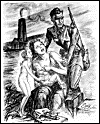
|
Selection for Gas Chambers / Sélection pour le gaz
1947, 41x51 cm,
Ghetto Fighters House, Israel.
|
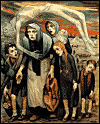
|
Unable to Work / Les inaptes au travail
131x162 cm, A Living
Memorial to the Holocaust, New York.
Inability to work was often an immediate death sentence. In the background of this painting, smoke rises from the crematorium to form the SS insignia. Of the one thousand Jews in the convoy that brought Olère to Auschwitz, 881 were immediately gassed. Only six of the 119 selected for work survived the War.
|
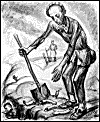
|
David Olère Burying the Remains of Children / David Olère enfouissant des restes d'enfants
32x40 cm, Olère Family.
Olère's first assignment at Auschwitz was as a grave digger of bunker 2. His prisoner number, 106144, is seen both on his shirt and as a tattoo on his left arm. That number appears in many of Olère's artworks, sometimes forming a part of the signature.
|
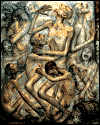
|
Gassing / Gazage
131x162 cm, A Living Memorial
to the Holocaust, New York.
The container in the lower right is labeled Zyklon B. Although Olère spent most of his time doing art for the SS and translating BBC radio broadcasts, he was, from time to time, called upon to help empty the gas chambers.
|
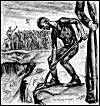
|
My First Dialogue / Mon premier dialogue
1949, 36x38 cm, Olère
Family.
Subtitled: "They also are responsible for the
war?" "Yes, that's war. "
|
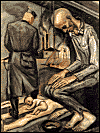
|
David Olère Punished in the Bunker / David Olère puni dans le bunker
46x61 cm, Yad Vashem Art Museum, Israel.
The cell was so narrow that
Olère was unable to sit, stretch or lie down for the 48 hours of his punishment.
|

|
The Oven Room / La salle des fours
1945, 58x38 cm, Ghetto Fighters House,
Israel.
A freight elevator in the background brought bodies up from the basement gassing chamber of Crematorium III at Birkenau. The wet trough at the right facilitated the dragging of bodies to the ovens.
|

|
The Experimental Injection / La piqûre expérimentale
1945, 92x72 cm,
A Living Memorial to the Holocaust, New York.
The infamous Dr. Mengele administers an injection as terrified prisoners look on.
|

|
For a Crust of Bread / Pour un bout de pain
1946, 21x27 cm,
Olère Family.
David Olère depicts himself writing letters for the SS
and decorating them with flowers in exchange for a crust of bread. Olère's talents as an artist and translator (he spoke Polish, Russian, Yiddish, French, English, and German) made him useful to the SS.
|

|
The Food of the Dead for the Living / Le vivres des morts pour les vivants
102x76 cm, A
Living Memorial to the Holocaust, New York.
Olère collects food, abandoned near the undressing rooms of crematorium III at Birkenau, so he can throw it over the fence to the prisoners at the women's camp.
|

|
Admission in Mauthausen / Admission á Mauthausen
1945, 34x23 cm, Ghetto
Fighters House, Israel.
In January of 1945, prisoners admitted to Mauthausen were forced to stand in the snow for three hours after a freezing shower. Olère was sent to Mauthausen after his evacuation from Auschwitz in a death march.
|

|
David Olère Working in a Tunnel at Melk / David Olère au travail dans un tunnel á Melk
1947, 20x38 cm, Olère Family.
From Mauthausen, Olère was sent to dig tunnels at the camp of Melk on the Danube. From Melk, he was sent to Ebensee where he worked until his liberation by American forces on May 6, 1945.
|
David Olère did not sketch for pleasure. He sketched in testimony to all those who never came back. The lone witness (Olère himself) is often present. The ghostly face observes with pain the inhuman scenes that cannot be erased from his photographic memory.
This short biography will contribute to an understanding of Olère's work.
